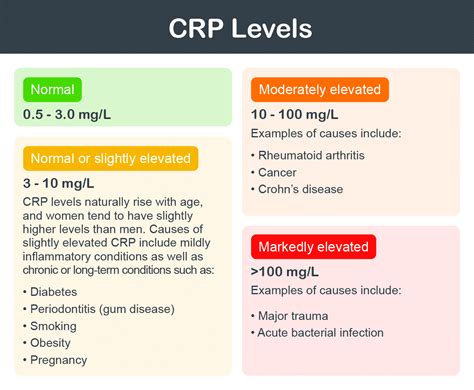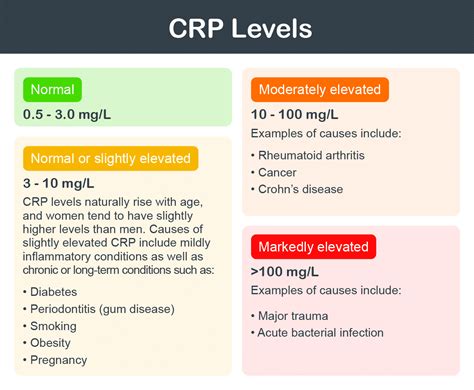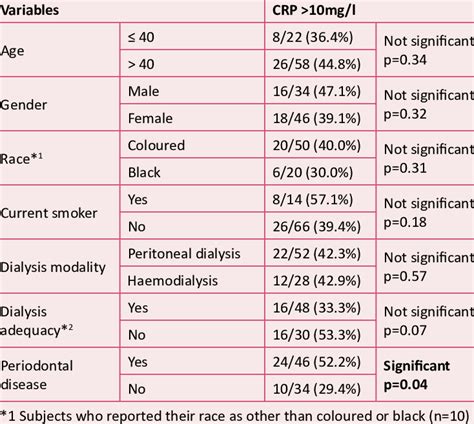Intro
Discover how CRP levels work, influencing inflammation, cardiovascular health, and disease risk, with 5 key methods explaining C-reactive proteins role in diagnostics and treatment, including chronic inflammation and immune response management.
The importance of understanding CRP levels cannot be overstated, as they play a crucial role in diagnosing and managing various health conditions. CRP, or C-reactive protein, is a protein produced by the liver in response to inflammation in the body. Elevated CRP levels can indicate the presence of inflammation, infection, or other underlying health issues. In this article, we will delve into the world of CRP levels, exploring their significance, working mechanisms, and the ways in which they can impact our health.
CRP levels are a vital tool in the medical field, allowing healthcare professionals to assess the level of inflammation in the body and make informed decisions about diagnosis and treatment. By monitoring CRP levels, doctors can identify potential health risks and develop effective strategies for managing inflammation and preventing long-term damage. Moreover, understanding CRP levels can empower individuals to take control of their health, making informed lifestyle choices that promote overall well-being.
The significance of CRP levels extends beyond the medical field, as they can also have a profound impact on our daily lives. Elevated CRP levels have been linked to an increased risk of chronic diseases, such as heart disease, diabetes, and certain types of cancer. By understanding how CRP levels work and taking steps to manage inflammation, individuals can reduce their risk of developing these conditions and improve their overall quality of life. In the following sections, we will explore the ways in which CRP levels work and their implications for our health.
Introduction to CRP Levels

How CRP Levels Are Measured
The measurement of CRP levels involves a simple blood test, which can be performed in a doctor's office or laboratory. The test typically involves drawing a blood sample from a vein in the arm, which is then sent to a laboratory for analysis. The results are usually available within a few hours or days, depending on the laboratory and the testing method used. There are two main types of CRP tests: a standard CRP test and a high-sensitivity CRP (hs-CRP) test. The hs-CRP test is more sensitive and can detect smaller amounts of CRP in the blood, making it a useful tool for assessing cardiovascular risk.The Role of CRP Levels in Inflammation

The Benefits of Monitoring CRP Levels
Monitoring CRP levels can have numerous benefits, particularly for individuals at risk of chronic diseases. By tracking CRP levels over time, healthcare professionals can identify potential health risks and develop effective strategies for managing inflammation. This can involve lifestyle changes, such as increasing physical activity, improving diet, and managing stress, as well as medications or other treatments to reduce inflammation. Additionally, monitoring CRP levels can help individuals to take control of their health, making informed lifestyle choices that promote overall well-being.5 Ways CRP Levels Work

Practical Examples of CRP Levels in Action
CRP levels can have a significant impact on our daily lives, particularly for individuals at risk of chronic diseases. For example, a person with a family history of heart disease may use CRP testing to assess their cardiovascular risk and develop strategies for reducing inflammation and promoting heart health. Similarly, an individual with a history of autoimmune disorders may use CRP testing to monitor their condition and adjust their treatment plan as needed.Managing CRP Levels

Statistical Data on CRP Levels
Statistical data on CRP levels can provide valuable insights into the prevalence and impact of inflammation on our health. For example, studies have shown that elevated CRP levels are associated with an increased risk of cardiovascular disease, with one study finding that individuals with CRP levels above 10 mg/L were at a 2-3 times higher risk of heart disease compared to those with lower CRP levels.Conclusion and Next Steps

What is CRP and why is it important?
+CRP, or C-reactive protein, is a protein produced by the liver in response to inflammation in the body. It is an important marker of inflammation and can be used to diagnose and monitor various health conditions.
How are CRP levels measured?
+CRP levels are measured through a blood test, which detects the amount of C-reactive protein present in the blood. The results are typically reported in milligrams per liter (mg/L) or milligrams per deciliter (mg/dL).
What are the benefits of monitoring CRP levels?
+Monitoring CRP levels can help identify potential health risks, develop effective treatment strategies, and promote overall health and well-being. It can also help individuals take control of their health and make informed lifestyle choices.
